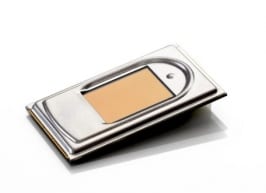August 14, 2013 – by Peter B. Counter
The rumors are persistent, and the closer the expected September iPhone 5S announcement gets, the more likely it seems that the next generation of Apple’s popular smartphone will be protected by a biometric fingerprint sensor. Two weeks ago, immediately after the new iOS dev kit was sent out to app developers, evidence surfaced corroborating the buzz and hearsay that’s been floating around since Apple purchased AuthenTec, and its fingerprint recognition patents, over a year ago for $350 million.
This rumor, if it proves to be true, is great news for the consumer. It’s no secret that passwords and PINs are antiquated. At this point, anybody who wants to protect their information, even just a little, is being forced to create two distinct passwords for every account (one actual and one for the applicable security question). Every password should be completely unique; lack any words found in a dictionary; contain numbers, letters and symbols; and be at least 12 characters long, but how many people want to be World War Two era code makers in their spare time?
Even if this practice could be implemented by everyone, the goal with passwords today is not to be uncrackable, but instead to take just long enough to get past that it isn’t worth a criminal’s time. The current state of affairs: come up with a code too long for a hacker’s billable hours; password creation has become a business consideration. Obviously higher security is needed and it looks like the market is choosing fingerprint sensors.
According to Bloomberg, Precise Biometrics shares have almost doubled since the AuthenTec acquisition, today adding 10 percent. Fingerprint Cards AB (FPC) has similarly been benefiting from these rumors, with Bloomberg reporting as much as a 2.1 percent gain.

Fingerprint Cards has been very public about how the iPhone rumors have been affecting business. Thanks to the unverified security measurement, the manufacturer has had clients postpone projects until 2014, considering area sensors as opposed to swipe sensors. In combination with Microsoft’s vocal support of fingerprint biometrics, FPC closed its second quarter, it’s best ever, citing the commercialization of fingerprint biometrics on personal devices as a major reason to look forward to profitability next year.
Possibly the most interesting thing in regards to this strengthening market is that there are mobile biometrics solutions that leverage a smartphone’s existing hardware already available. Take EyeVerify for example: an app available for iOS and Android devices that turns the front facing camera into an iris scanner. This app is a comparatively simple solution to that of native fingerprint recognition, since it is a software solution that can operate on the current generation of mobile devices. The ability to turn a smartphone into an iris scanner is a technology available right now, yet fingerprint scanning on an iPhone is driving biometrics stock up and it’s still just a rumor.
This speaks volumes about Apple’s reputation of setting trends that stick, but it also has a lot to do with the nature of protecting sensitive information. Over 60 percent of smartphone owners in 2011 didn’t even protect their phones with a simple PIN, according to Frost & Sullivan Market Insight. Google’s five year road map will see its users forced into two step authentication. People don’t want to seek out security solutions, in fact they resist them. A fingerprint reader in the home button of the next iPhone can be Apple’s way of saying “you have to protect your accounts, you have no choice.” The people will listen as the market already has.


Follow Us